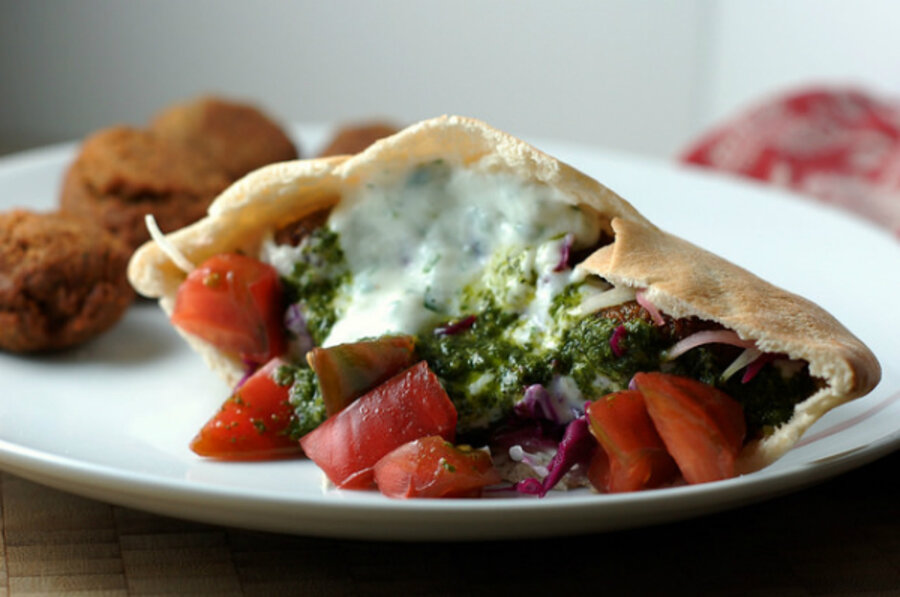Meatless Monday: Fantastic falafel from scratch
Loading...
For some reason, I’ve had failure after failure with boxed falafel mixes. I follow the instructions to the letter but when it comes time to fry or bake the falafel falls apart and I’m left with a crumbly, oily mess that no one can eat. It’s a mystery. And embarrassing, especially when I’ve invited people over – "Come for falafel! ... I mean pizza."
But since falafel is such good stuff – tasty, filling, packed with protein and downright good for you – I decided to try making my own using dried chickpeas. It sounds hard but it isn’t at all. The end result held together beautifully and my kids actually deigned to eat it which is nothing short of a miracle these days unless I’ve slaved over a pot of Annie’s boxed mac ‘n’ cheese (the orange cheddar kind with the mini-shell pastas, to be precise).
Making falafel from scratch sounds way more intimidating than it actually is. The biggest hurdle is just remembering to soak the chickpeas the night before.
I’m making an effort to move away from using canned beans of late. Dried beans have so much going for them: They taste better, they’re healthier because there’s no can to leach chemicals into the beans, they’re easier on the environment, and they’re cheaper to boot. But I still use canned beans sometimes and you can certainly use them to make this delicious falafel without any judgment from me. If you do use canned garbanzos, I suggest Eden Organics because I think they are the only company whose cans are BPA-free at this point, regardless of their internal politics.
A few hours before you want to eat the falafel, drain the chickpeas and add the flavorings of your choice to the bowl of your food processor. I used fresh cilantro, scallions, parsley, dried cumin, smoked paprika and garlic – “num-num,” as my niece Lila used to say.
Pulse until it is well-blended but not totally pureed. Then put in a bowl, cover and refrigerate for a few hours.
Then it’s time to shape the falafels. You can either form little balls or make them slightly larger and “smoosh” them down to make patties.
I fried these in grapeseed oil – my new favorite frying oil for it’s mild taste and high smoke point. I also love using peanut oil but it’s hard to find here in the hinterlands. Make sure you have enough oil and that you get it hot enough (but not smoking – that’s too hot!) to fry them quickly, otherwise they soak up the oil instead of frying and you’ll end up with soggy, greasy falafels.
Flip them once and once they’re nicely browned all over, drain them on a paper grocery bag which are superior to paper towels because they’re thicker and it just takes one of them instead of using up half a roll of paper towels. I toss the greasy bag in my woodstove when I’m finished with it.
Then serve warm with the toppings of your choice. My toppings were inspired by a great falafel place called Chick-O-Pea’s that opened all too briefly in our old neighborhood in North Berkeley. They offered a dizzyingly delicious selection of fixings including a ton of tasty pickled veggies and sauces.
I served my falafel with shredded cabbage, chopped tomatoes, my favorite pickled beets, some quick pickled onions, cucumber and herb raita, a brilliantly green chimichurri, and a creamy, garlicky tahini yogurt sauce. If you make any of these sauces, try to make them a day ahead or first thing in the morning as they get better with age.
Truly, a feast for all of the senses as it was also beautiful and smelled divine. And vegan to boot. These can also be gluten-free – just substitute a gluten-free flour for the wheat flour in the recipe. I’m not an expert on gluten-free flours but have used Bob’s Red Mill flour with good results in the past.
Fantastic Falafel
Serves 4 – makes about 20 balls or 12 patties
1 cup dried chickpeas or 1 15- to 16-ounce can of chickpeas, drained
5 scallions or 1/2 large onion, chopped
4 tablespoons chopped fresh parsley
4 tablespoons chopped fresh cilantro
4 cloves of garlic, minced or pressed (if they’re huge, just use 2 or 3 cloves)
1 tablespoon dried cumin
1 teaspoon smoked paprika
1 teaspoon sea salt
1 teaspoon freshly ground black pepper
1 teaspoon baking powder
4-6 tablespoons flour (or more, if needed)
A lot of grapeseed or peanut oil for frying
1. Place the dried chickpeas in a large bowl and cover with cold water by at least 2 inches. Put the chickpeas in a large bowl and add enough cold water to cover them by at least 2 inches. Soak overnight and then drain. If you prefer to use canned chickpeas, simply drain them.
2. Place the chickpeas, scallion or onion, garlic, herbs and spices in the bowl of your food processor and blend until well-blended but not pureed. Then sprinkle the baking powder and flour over the mixture and pulse. The goal is to add just enough flour to enable you to form some of this dough/batter into a small ball without it sticking. If you need to add a little bit more flour to achieve that consistency, that’s fine.
3. Transfer the dough into a bowl, cover and refrigerate for a few hours. When it’s time to get cooking, form the mixture into little walnut-sized balls (about the size of a walnut) or make them slightly larger and flatten them into little discs.
4. Pour a good amount of oil (you want to shoot for 2 inches or more) in a cast iron skillet or a heavy-bottomed pot or pan Heat 3 inches of oil to 375 degrees F. in a deep pot or wok and fry 1 ball to test. If it falls apart, add a little flour. Then fry about 6 balls at once for a few minutes on each side, or until golden brown. Drain on paper towels. Serve in pita or on lettuce with your choice of sauces, pickles and fresh veggies.
Related post on The Garden of Eating: Cumin-Scented Quinoa With Grated Beets & Quick Curried Chickpeas








